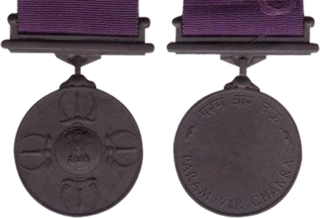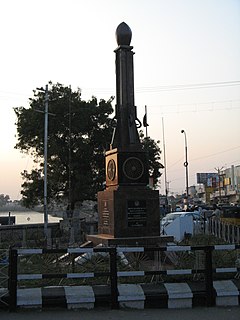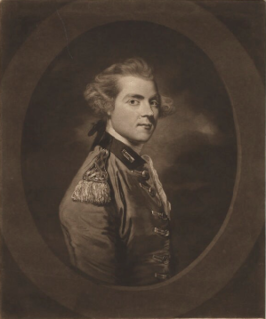Colonel George Bruce Malleson was an English officer in India and author.

The Indian Rebellion of 1857 was a major uprising in India in 1857–58 against the rule of the British East India Company, which functioned as a sovereign power on behalf of the British Crown. The rebellion began on 10 May 1857 in the form of a mutiny of sepoys of the Company's army in the garrison town of Meerut, 40 mi (64 km) northeast of Delhi. It then erupted into other mutinies and civilian rebellions chiefly in the upper Gangetic plain and central India, though incidents of revolt also occurred farther north and east. The rebellion posed a considerable threat to British power in that region, and was contained only with the rebels' defeat in Gwalior on 20 June 1858. On 1 November 1858, the British granted amnesty to all rebels not involved in murder, though they did not declare the hostilities to have formally ended until 8 July 1859. Its name is contested, and it is variously described as the Sepoy Mutiny, the Indian Mutiny, the Great Rebellion, the Revolt of 1857, the Indian Insurrection, and the First War of Independence.

The Param Vir Chakra (PVC) is India's highest military decoration, awarded for displaying distinguished acts of valour during wartime. Param Vir Chakra translates as the "Wheel of the Ultimate Brave", and the award is granted for "most conspicuous bravery in the presence of the enemy". As of January 2018, the medal has been awarded 21 times, of which 14 were posthumous and 16 arose from actions in Indo-Pakistani conflicts. Of the 21 awardees, 20 have been from the Indian Army, and one has been from the Indian Air Force. Major Somnath Sharma, was the first recipient. A number of state governments of India as well as ministries of the central government provide allowances and rewards to recipients of the PVC.

Sepoy was originally the designation given to a professional Indian infantryman, traditionally armed with a musket, in the armies of the Mughal Empire.

Mangal Pandey was an Indian soldier who played a key part in the events immediately preceding the outbreak of the Indian rebellion of 1857. He was a sepoy (infantryman) in the 34th Bengal Native Infantry (BNI) regiment of the British East India Company. In 1984, the Indian government issued a postage stamp to remember him. His life and actions have also been portrayed in several cinematic productions.

Shaikh Paltu was a soldier (sepoy) with the British East India Company who served in the 34th Bengal Native Infantry in March 1857, shortly before widespread discontent broke out in the Bengal Army. When on March 29, Sepoy Mangal Pandey of the same regiment attacked a British officer, it was Shaikh Paltu, who saved the life of the adjutant by seizing Mangal Pandey. The sepoys of the quarter guard on duty and others present refused to take any action against their comrade and remained as "idle spectators of a murderous assault".
The Central India Campaign was one of the last series of actions in the Indian rebellion of 1857. A small British and Indian Army overcame a disunited collection of states in a single rapid campaign, although determined rebels continued a guerrilla campaign until the spring of 1859.
The White Mutiny was the unrest that occurred at the dissolution of the "European Forces" of the British East India Company in India during the mid-19th century in the wake of the Indian Rebellion of 1857.
Historians have identified diverse political, economic, military, religious and social causes of the Revolt of 1857.

The Bengal Army was the army of the Bengal Presidency, one of the three presidencies of British India within the British Empire.

The regiments of Bengal Native Infantry, alongside the regiments of Bengal European Infantry, were the regular infantry components of the East India Company's Bengal Army from the raising of the first Native battalion in 1757 to the passing into law of the Government of India Act 1858. At this latter point control of the East India Company's Bengal Presidency passed to the British Government. The first locally recruited battalion was raised by the East India Company in 1757 and by the start of 1857 there were 74 regiments of Bengal Native Infantry in the Bengal Army. Following the Mutiny the Presidency armies came under the direct control of the United Kingdom Government and there was a widespread reorganisation of the Bengal Army that saw the Bengal Native Infantry regiments reduced to 45.
The 5th Light Infantry was an infantry regiment of the Bengal Army and later of the raj-period British Indian Army. It could trace its lineage back to 1803, when it was raised as the 2nd Battalion, 21st Bengal Native Infantry. The regiment was known by a number of different names: the 42nd Bengal Native Infantry 1824–1842, the 42nd Bengal Native (Light) Infantry 1842–1861, the 5th Bengal Native (Light) Infantry 1861–1885 and the 5th Bengal (Light) Infantry 1885–1903. Its final designation 5th Light Infantry was a result of the Kitchener Reforms of the Indian Army, when all the old presidency titles (Bengal) were removed. During World War I the regiment was stationed in Singapore and was notorious for its involvement in the 1915 Singapore Mutiny. The regiment was disbanded in 1922, after another set of reforms of the post World War I Indian Army.
Thomas Adams, British Army major, posthumously promoted to brigadier-general based on accounts of his defence of the British position in Bengal in 1763.

The Vellore mutiny, or Vellore Revolution, occurred on 10 July 1806 and was the first instance of a large-scale and violent mutiny by Indian sepoys against the East India Company, predating the Indian Rebellion of 1857 by half a century. The revolt, which took place in the South Indian city of Vellore, lasted one full day, during which mutineers seized the Vellore Fort and killed or wounded 200 British troops. The mutiny was subdued by cavalry and artillery from Arcot. Total deaths amongst the mutineers were approximately 350; with summary executions of about 100 during the suppression of the outbreak, followed by the formal court-martial of smaller numbers.
During the Indian Rebellion of 1857 a column of troops led by the commander of the 24th Regiment of Foot was sent to disarm Bengal Native Infantry units believed to be at risk of mutiny in Rawalpindi and Jhelum. At Rawalpindi, the 58th Bengal Native Infantry were disarmed peacefully, however the two companies of the 14th Bengal Native Infantry resisted the attempt by force of arms. These two companies were quickly defeated by the British, loyal native troops and the local population. In Jhelum, also garrisoned by the 14th, the concurrently timed disarmament was much more violent. Thirty five British soldiers of the 24th Regiment of Foot were killed along with a number of Loyal Indian troops, by mutinous sepoys of the 14th Bengal Native Infantry. When the mutineers realised that they, with the exception of the Sikhs, were to be disarmed, they mutinied and made a vigorous defence against the force that had arrived from Rawalpindi to disarm them. The following night a significant number of mutineers managed slip away but most were subsequently arrested by the Kashmir authorities, into whose territory they had escaped.

The Barrackpore mutiny was a rising of native Indian sepoys against their British officers in Barrackpore in November 1824. The incident occurred when the British East India Company was fighting the First Anglo-Burmese War (1824–1826) under the leadership of the Governor-General of Bengal, William Amherst, 1st Earl Amherst.

The Mysore Medal is a campaign medal that was awarded by the Governor-General of India to native Indian soldiers of the armies of the Honourable East India Company (HEIC) who participated in the Third Anglo-Mysore War of 1790 to 1792.

The Monghyr Mutiny occurred among European officers of the East India Company stationed in Bengal in 1766. The mutiny arose after the East India Company's governor of Bengal, Robert Clive, implemented an order to reduce the batta field allowance paid to its army officers. The batta had been doubled while the troops were in the service of the Nawab of Bengal Mir Jafar. Clive's order came into effect on 1 January 1766 and brought the allowances into line with those paid by the company in the rest of India. At this time the company army in Bengal was divided into three brigades under the command of Sir Robert Fletcher, Richard Smith and Robert Barker.

Sir Robert Fletcher was an officer of the East India Company and a member of parliament for Cricklade. Fletcher joined the East India Company as a junior clerk in 1757 but soon transferred to its army. As a lieutenant he was cashiered (dismissed) for insolence but was later restored. Fletcher was awarded a knighthood for gallantry in battle and rose in rank to lieutenant-colonel in command of a brigade. He was court-martialled and cashiered for the second time by Robert Clive for involvement in the 1766 Monghyr Mutiny.
The following is the list of orders, decorations and medals related to British India:












